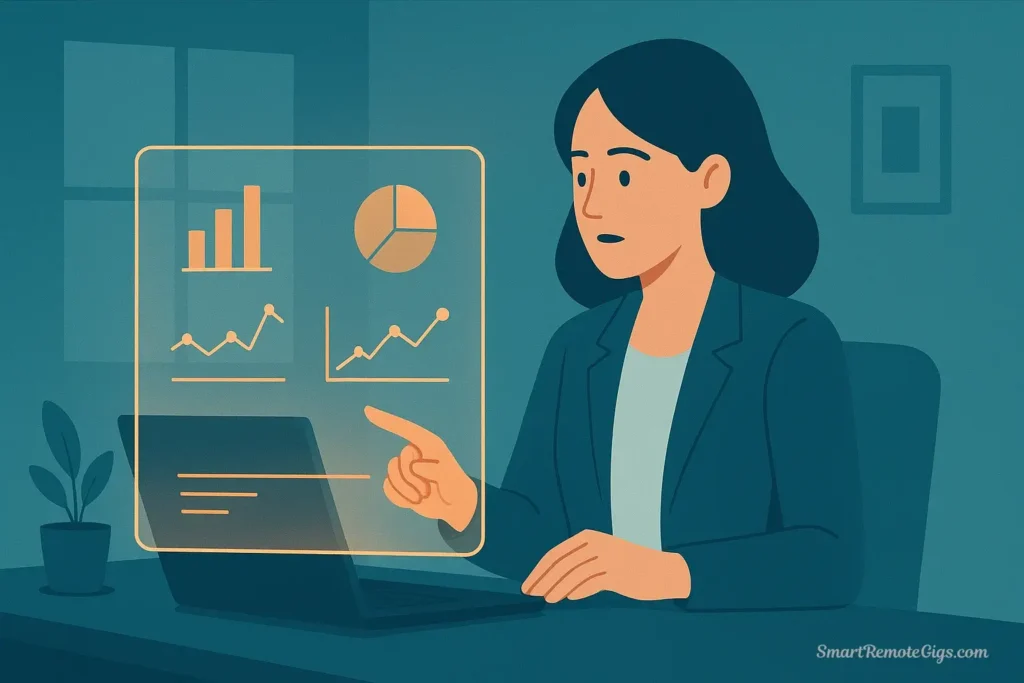Meet Sarah. She’s a mid-level social media manager for a direct-to-consumer wellness brand with a growing Instagram presence, an active TikTok community, and a professional LinkedIn page. She works entirely remotely from her apartment in Portland, managing content for three platforms while collaborating with a small marketing team spread across two time zones.
Sarah’s mornings start with coffee and her laptop. Her evenings end with her closing Slack notifications and stepping away from her desk—a boundary she’s learned to protect. In between, her day in the life of a social media manager is a carefully choreographed mix of creative work, community engagement, data analysis, and strategic planning.
While no two days are identical—a trending topic might hijack her afternoon, or a campaign launch might shift her entire week—this schedule represents a typical Tuesday for Sarah. It’s the rhythm she’s developed to balance the proactive, reactive, and strategic work that defines modern social media management.
If you’ve ever wondered what it’s really like to work as a remote social media professional, this behind-the-scenes look at Sarah’s social media manager daily tasks will give you the full picture—from the energizing moments of viral content to the unglamorous reality of analytics spreadsheets.
The Morning (9 AM – 12 PM): Proactive Mode

The morning is Sarah’s most productive window. She’s learned that her brain works best for strategic and creative tasks before noon, so she protects this time fiercely. This is when she creates content, engages with her community, and tackles work that requires deep focus.
9:00 AM: The Digital Commute & Morning Check-In
Sarah’s workday begins with what she calls her “digital commute”—a 15-minute ritual that helps her transition from personal time to work mode, even though she’s just moving from her kitchen to her home office.
She opens Slack first, scanning the marketing team channel for any overnight messages or urgent requests. Her manager has left a note about a potential collaboration with a wellness influencer—something to discuss in their 1:1 later this week. The customer service team has flagged a comment thread on yesterday’s Instagram post where a customer is asking about product ingredients. Sarah makes a mental note to address it in her community engagement block.
Next, she opens her social media management dashboard—her team uses Buffer to schedule posts and track performance across platforms. She reviews yesterday’s metrics at a glance: the TikTok video she posted about “morning routines for better sleep” performed exceptionally well (47K views, 3.2K likes, 8.9% engagement rate), but the LinkedIn article share underperformed compared to typical benchmarks.
She checks each platform natively as well, looking for any comments that need immediate attention, particularly anything negative or time-sensitive. Everything looks manageable today—no fires to put out, which is always a relief.
Time investment: 15 minutes
9:30 AM: Community Engagement Block
With her morning coffee in hand, Sarah dedicates her next hour to pure community engagement. This is the human side of social media management—the relationship building that algorithms reward and audiences appreciate.
She starts on Instagram, where most of their audience engagement happens. She responds to 23 comments on yesterday’s posts, making sure each reply feels personal rather than templated. When someone asks about the sustainability of their packaging, Sarah doesn’t just say “thanks for asking!”—she provides a detailed answer and links to their sustainability page.
She moves through her DMs next. Three are customer service questions (she forwards these to the support team with context), four are potential collaboration inquiries from micro-influencers (she saves these to review with her manager), and several are genuine messages from community members sharing their experiences with the products. These last ones are gold—Sarah screenshots them for potential user-generated content and responds with authentic appreciation.
On TikTok, she engages with comments on their recent viral video. The algorithm rewards early engagement, so responding to comments within the first few hours of posting significantly boosts visibility. She also takes time to engage with their audience’s content—liking and commenting on videos from followers who tag their brand or use their branded hashtag.
LinkedIn is quieter, but Sarah still responds to the handful of comments on their latest article about workplace wellness practices. The audience here is different—more professional, more likely to ask thoughtful questions—so her responses are more detailed and slightly more formal than her Instagram voice.
Time investment: 1 hour
10:30 AM: Deep Work: Content Creation
This is Sarah’s favorite part of the day. She blocks off 90 minutes for uninterrupted content creation—the creative, strategic work that fills next week’s content calendar.
Today, she’s working on content for their upcoming product launch. She starts by reviewing the campaign brief from the product marketing team, pulling out key messages and features that need to be communicated across platforms.
She opens Canva and begins designing graphics for Instagram. Using the brand template she created months ago, she produces three carousel posts that break down the science behind their new product. Each slide needs to be visually engaging, informative, and optimized for mobile viewing. She experiments with different color schemes and layouts, settling on a vibrant, energetic design that aligns with their brand guidelines.
Next, she writes captions. This is where platform expertise matters—the caption for Instagram is conversational and emoji-forward, asking a question to drive comments. The LinkedIn caption for the same content is more professional, leading with a statistic and positioning the product as a solution to a workplace wellness challenge.
She also scripts a TikTok video she’ll shoot this afternoon. The concept: a quick “get ready with me” style video where she unpacks the product and shares first impressions. She writes out key talking points but keeps it loose—TikTok audiences can smell overly scripted content from a mile away.
By noon, she’s created content assets for six posts across three platforms, drafted captions, identified relevant hashtags, and added everything to the shared content calendar for team review.
Time investment: 1.5 hours
The Midday (12 PM – 3 PM): Reactive & Collaborative Mode

After an intensive morning of focused work, Sarah’s midday shifts toward collaboration and reactive tasks. This is when team meetings happen, when she monitors real-time trends, and when she’s most available for spontaneous communication with colleagues.
12:00 PM: Lunch & A Screen Break
Sarah has learned the hard way that working through lunch leads to afternoon burnout. She closes her laptop, makes a sandwich, and deliberately steps away from her desk. Sometimes she goes for a walk. Today, she sits on her balcony and reads a few chapters of a novel.
This break is non-negotiable in her social media manager schedule. The always-on nature of social media makes boundaries essential—without them, she’d be checking notifications at 10 PM and feeling perpetually overwhelmed.
Time investment: 45 minutes
1:00 PM: Team Sync Meeting
Back at her desk, Sarah joins the weekly marketing team video call. Today’s agenda includes a campaign retrospective on last month’s influencer partnership (results were strong—they’re discussing doing something similar for the holidays), updates on the product launch timeline (it’s been moved up by a week, which means Sarah needs to accelerate some of her content creation), and a brainstorming session about their Black Friday strategy.
Sarah shares her screen to present last week’s social media performance highlights. She’s gotten good at translating data into stories that non-social-media people understand—rather than just listing engagement rates, she explains that their audience is particularly responsive to educational content about sleep science and stress management, which should inform their content strategy going forward.
The meeting wraps with clear action items. Sarah has volunteered to research potential wellness micro-influencers for a holiday campaign, and she’s responsible for developing a content calendar for the week leading up to Black Friday.
Time investment: 1 hour
2:00 PM: Social Listening & Trend Spotting
With formal meetings done, Sarah shifts into exploration mode. She opens TikTok—not to post, but to watch. She spends 30 minutes scrolling through her For You Page, paying attention to trending audio clips, emerging content formats, and what wellness creators in their niche are doing.
She discovers a trending audio that’s perfect for a video about nighttime routines. She saves it and makes a note to create content around it this week while it’s still gaining momentum. Timing matters with trends—jump on them too late and they feel stale; catch them early and you ride the wave of discovery.
She also checks industry news and what competitors are posting. A competitor just launched a similar product to theirs—their messaging emphasizes “science-backed ingredients,” which is close to their own positioning. Sarah makes a note to discuss this with her manager; they may need to sharpen their differentiation.
She monitors their brand mentions across platforms using their social listening tool. Most mentions are positive, though she notices a small thread on Reddit where customers are discussing whether their products are actually worth the price point. She reads through the conversation carefully, taking notes on common concerns that might inform future FAQ content or address potential objections in their messaging.
Time investment: 45 minutes
The Afternoon (3 PM – 5 PM): Strategic Mode

Sarah’s afternoons are reserved for analytical and administrative work—the behind-the-scenes tasks that ensure everything runs smoothly and improves over time.
3:00 PM: Analytics & Reporting
Every Tuesday, Sarah dedicates time to pulling and analyzing performance data. This week, she’s creating the monthly social media report that goes to the entire marketing team and leadership.
She opens Google Analytics to track how much traffic their social channels are driving to the website. Instagram Stories with swipe-up links drove 342 clicks last month—down 12% from the previous month, which she hypothesizes might be due to reduced posting frequency during a team member’s vacation.
She exports data from each platform’s native analytics: Instagram Insights, TikTok Analytics, and LinkedIn Analytics. She’s looking for patterns—which content types drive the most engagement, what posting times perform best, how their follower demographics are shifting, and whether they’re making progress toward their quarterly goals.
The story emerging from this month’s data is clear: video content significantly outperforms static posts across all platforms (average engagement rate of 6.8% for video vs. 3.2% for images), educational content about sleep science resonates particularly strongly (highest save rates), and their audience is most active between 7-9 PM on weekdays.
She compiles this into a visual report using Google Slides, including key metrics, notable wins (that viral TikTok!), areas for improvement (LinkedIn engagement has been flat), and strategic recommendations for next month (invest more in video content, experiment with posting times, develop more sleep-focused educational series).
Time investment: 1.5 hours
Wondering what all these tasks and responsibilities mean? See our full breakdown in What Does a Remote Social Media Manager Do? to understand how each activity contributes to the broader role.
4:30 PM: Plan & Close Out
The final 30 minutes of Sarah’s day are dedicated to organization and planning. She reviews her to-do list, checking off completed items and prioritizing tomorrow’s work. She adds tasks to her project management board in Asana: “Draft holiday campaign content calendar,” “Research 10 potential influencer partners,” “Schedule next week’s content.”
She queues up tomorrow’s posts in Buffer, double-checking that captions are error-free, images are properly sized, and posting times align with when their audience is most active. She sets up a reminder to check on the morning post’s performance around 10 AM tomorrow.
Finally, she sends a quick end-of-day Slack message to her manager with a progress update on the product launch content. Clear communication is essential when working remotely—her manager is on the East Coast and will be logging off soon, so Sarah makes sure to close any open loops before end of day.
At 5:00 PM, Sarah closes her laptop. She’s learned that the work of social media management is never truly “done”—there’s always another trend to monitor, another post to optimize, another comment to respond to. But creating clear boundaries between work time and personal time is essential for avoiding burnout in this always-on profession.
Time investment: 30 minutes
The Flexibility of Remote Work
Sarah’s remote work routine isn’t rigid. Some days look completely different—a brand crisis might mean spending hours on damage control and stakeholder communication. A campaign launch might require working closely with the product team all day. A creative breakthrough might mean spending an entire afternoon shooting and editing TikTok videos.
The beauty of remote social media management is flexibility. If Sarah needs to run an errand at 2 PM, she can shift her analytics work to the evening. If she’s feeling particularly creative at 7 AM, she can start early and finish early. As long as the work gets done, her manager cares about results, not hours logged.
But this flexibility requires discipline. Sarah has systems: a detailed content calendar that prevents last-minute scrambles, time-blocking that ensures deep work doesn’t get crowded out by reactive tasks, and clear boundaries that prevent work from bleeding into evenings and weekends.
She’s also learned to build buffer time into her schedule. Social media is inherently unpredictable—a customer complaint can escalate, a post can unexpectedly go viral and require rapid response, or a platform algorithm change can demand immediate strategy adjustment. Having breathing room in her calendar allows her to handle these surprises without everything derailing.
The remote aspect also means Sarah rarely has “water cooler” moments with colleagues. She’s intentional about staying connected—she schedules virtual coffee chats with teammates, actively participates in the team’s Slack channels beyond just work talk, and makes sure to turn on her camera during video meetings to maintain that human connection.
After two years as a remote social media manager, Sarah has found her rhythm. The work is demanding, fast-paced, and requires constant learning. But it’s also creative, impactful, and offers the flexibility to design a work life that fits her personal priorities. She wouldn’t trade it for a traditional office job.
Want to understand the skills behind each of these tasks? Check out The Top 10 Skills Every Remote Social Media Manager Needs to see which competencies will help you excel in each part of this daily routine.
Turn This ‘Day in the Life’ into Your Reality
You’ve just walked through a typical day for a remote social media manager. You’ve seen the blend of creative content creation, proactive community engagement, detailed data analysis, and strategic collaboration that defines this exciting career.
If reading about Sarah’s day—the challenges, the creative moments, and the flexibility—has you excited and motivated, your next question is likely, “How do I get there myself?”
Seeing the “what” is one thing. Learning the “how” is the next critical step. That’s where our pillar guide comes in. It’s the strategic roadmap that takes you from where you are now to landing a role just like Sarah’s, covering everything from building a portfolio with no experience to nailing the remote interview.
➡️ Your Complete Roadmap: How to Become a Remote Social Media Manager (The Complete 2025 Guide)






